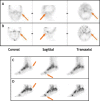Feasibility study of a novel general purpose CZT-based digital SPECT camera: initial clinical results
- PMID: 29536291
- PMCID: PMC5849748
- DOI: 10.1186/s40658-018-0205-z
Feasibility study of a novel general purpose CZT-based digital SPECT camera: initial clinical results
Abstract
Background: The performance of a prototype novel digital single-photon emission computed tomography (SPECT) camera with multiple pixelated CZT detectors and high sensitivity collimators (Digital SPECT; Valiance X12 prototype, Molecular Dynamics) was evaluated in various clinical settings. Images obtained in the prototype system were compared to images from an analog camera fitted with high-resolution collimators. Clinical feasibility, image quality, and diagnostic performance of the prototype were evaluated in 36 SPECT studies in 35 patients including bone (n = 21), brain (n = 5), lung perfusion (n = 3), and parathyroid (n = 3) and one study each of sentinel node and labeled white blood cells. Images were graded on a scale of 1-4 for sharpness, contrast, overall quality, and diagnostic confidence.
Results: Digital CZT SPECT provided a statistically significant improvement in sharpness and contrast in clinical cases (mean score of 3.79 ± 0.61 vs. 3.26 ± 0.50 and 3.92 ± 0.29 vs. 3.34 ± 0.47 respectively, p < 0.001 for both). Overall image quality was slightly higher for the digital SPECT but not statistically significant (3.74 vs. 3.66).
Conclusion: CZT SPECT provided significantly improved image sharpness and contrast compared to the analog system in the clinical settings evaluated. Further studies will evaluate the diagnostic performance of the system in large patient cohorts in additional clinical settings.
Keywords: CZT; Clinical; General purpose; SPECT.
Conflict of interest statement
Ethics approval and consent to participate
All procedures performed in studies involving human participants were in accordance with the ethical standards of the institutional and/or national research committee and with the 1964 Helsinki Declaration and its later amendments or comparable ethical standards.
Consent for publication
Informed consent was obtained from all individual participants included in the study, including the publication of results.
Competing interests
L. Beilin, T. Kenig, and E. Stern were employed by Molecular Dynamics. Dr. Ben-Haim is an advisor of Molecular Dynamics.
Publisher’s Note
Springer Nature remains neutral with regard to jurisdictional claims in published maps and institutional affiliations.
Figures





References
-
- Amrami R, Shani G, Hefetz Y, Blevis I, Pansky A. A comparison between the performance of a pixellated CdZnTe based gamma camera and Anger NaI(TI) scintillator gamma camera in Proceedings of the 22nd Annual International Conference of the IEEE: Washington, D.C: IEEE; 2000. p. 352–5.
LinkOut - more resources
Full Text Sources
Other Literature Sources

